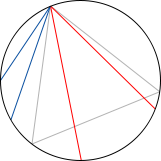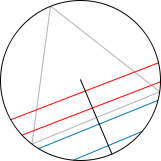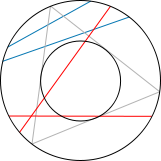Bertrand Paradox
Classically, we define the probability of an event as the ratio of the favorable cases, over the number of all possible cases. Of course, these possible cases need to be all equally likely. This works great for discrete settings, like dice rolls, card games, etc. But when facing non-discrete cases, this definition needs to be revised, as the following example shows:
Consider an equilateral triangle inscribed in a circle. Suppose a chord of the circle is chosen at random. What is the probability that the chord is longer than a side of the triangle?



First example Second example Third example
Using the classical definition of probability, three different students attacked this problem independently, and found each a different result: In all three examples, assume the circle has radius 1.
- Fix any point, say
in the circle. Consider any random chord in the circle, by choosing any other point
on it. The number of possible cases is thus
Place one of the vertices of the equilateral triangle on
, and notice that the circle gets partitioned in three arcs with equal length
Only if
belongs in the arc farthest to
we will have a chord longer than the side of the triangle. Therefore, the number of favorable cases is
Consequently, the probability we are looking for is
- Choose any point
on the circle, any point
on the radius
and consider the chord formed from the perpendicular to
by
There are
possible cases. Place the equilateral triangle so that one of the sides is perpendicular to
and notice that the number of favorable cases coincide with those chords where
is nearer the center of the circle than the point where the side of the triangle intersects the radius. A simple trigonometric computation tells us that the number of favorable cases is precisely
and thus the probability we are looking for is
- Choose any point
in the interior of the disk, and consider the only chord that has
as a midpoint. There are
possible cases. The chord will be longer than the side of the triangle, only if the chosen point falls within a concentric circle of radius
The number of favorable cases is thus the area of this circle:
The probability we are looking for is in this case
The three methods are sound: why did we get different answers? Which student do you think got it “right”? Can you explain what the paradox is in this situation?




I started out my mathematical life doing integral geometry and at some point had to think hard about this question. The problem is that there are many measures on the space of chords and it depends on what you are doing as to which is the most “natural” to use. If one is constructing the chords by choosing two points on the circle and then connecting them, then the first solution is the most natural.
For those of use who have done integral geometry (= geometric probability) the natural way to look at this is as follows. Let Λ be the set of all lines in the plane. This has a measure, dL, discovered by the English mathematician Crofton in the late 1800’s such that for any bounded convex set D
∫ length ( D ∩ L ) dL = Area( D )
The set of chords in D is the set C := { D ∩ L : L ∈ Λ }. Note for any chord S ∈ C there
is a unique line Ŝ such that D ∩ Ŝ = S. The we give the space of chords, C, the measure induced from Λ, that is if A ⊆ C
measure of A in C = measure of { Ŝ : S ∈ A } in Λ
This gives a uniform method of defining a measure on the set of chords of a bounded convex sets that has some nice properties (such as translation and rotation invariance).
Then a calculation, that is not that hard, but long enough that I don’t want to type it, gives that using this measure on the space of chords to a circle that the probability is 1/2, that is the second of those above. But again it depends on the measure we choose on the spaces of chords what the correct answer is.
Thanks for the comment, Ralph! I just came up with this nice follow-up question: For what values does it exist a measure
does it exist a measure  on the space of chords so that "the probability that the chord is longer than a side of the triangle" is exactly
on the space of chords so that "the probability that the chord is longer than a side of the triangle" is exactly  ? My guess (and I think I know how to prove this) is that at least we should be able to find such
? My guess (and I think I know how to prove this) is that at least we should be able to find such  for
for  We might be even able to find for all
We might be even able to find for all  although counter-intuitive. What do you think?
although counter-intuitive. What do you think?
I cannot believe that I reached this ripe old age without learning of this paradox! (More likely, I used to know about it and I forgot already.)
Along similar lines: what is the average number of real roots of a real polynomial of degree d? There are a few such results, the range I know is from root d to d/3. I don’t know all the details, but you pick coefficients independently and the key question is coefficients in which basis, with the larger bound obtained with the Chebyshev basis.
That’s a nice one too! Care to elaborate? I will include it in a post.
Here is a solution to your problem. For 0 < p < 1, choose a probability measure, μ, on the unit disk such that the disk of radius 1/2 has measure p. There are many such measures and we can even choose μ to be rotationally symmetric. If we then parametrize the chords by their midpoints, as in your third solution above, then the required probability is p.
That’s a nice one! I guess that, although there is a modification on the way lengths and areas are measured, the length of any chord with midpoint in the inner circle will still have length larger than that on the side of the equilateral triangle.
Do you think we can get it without altering the way we measure lengths and areas? I would like to keep the area of that circle as as well as the lengths of segments from
as well as the lengths of segments from  to
to  to be
to be 